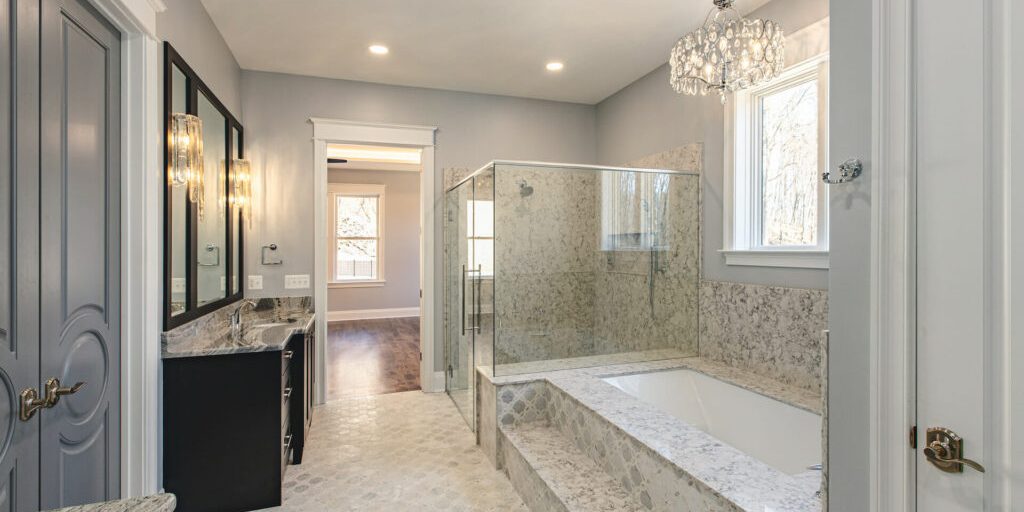Bathroom remodeling can significantly enhance the value and comfort of your home. Whether you’re looking to update a few fixtures or aiming for a complete overhaul, this guide will navigate you through every step, ensuring a smooth and successful bathroom transformation.
Planning Your Bathroom Remodel
Setting a Budget
The first step in bathroom remodeling is to set a realistic budget. Consider all potential costs, from materials to labor, and always reserve a portion for unexpected expenses. Smart budgeting ensures your project stays on track financially.
Choosing a Design Theme
Your bathroom should reflect your style. Whether you prefer a modern, traditional, or eclectic look, selecting a cohesive design theme is crucial. This decision will guide your choices in materials, colors, and fixtures.
Creating a Functional Layout
Efficient use of space is paramount in bathroom remodeling. Work with a designer or contractor to create a layout that maximizes function without compromising style. Consider the placement of each element, from the vanity to the shower, for optimal flow and usability.
Essential Components of Bathroom Remodeling
Upgrading Fixtures
New fixtures can dramatically improve the look and functionality of your bathroom. Opt for models that combine style with water efficiency to enjoy savings and enhanced performance.
Choosing Flooring and Tiles
Durability and safety are key when selecting bathroom flooring and tiles. Look for slip-resistant materials that can withstand high moisture levels, such as porcelain or natural stone.
Improving Lighting and Ventilation
Proper lighting and ventilation are essential for a comfortable and mold-free bathroom. Incorporate a mix of natural and artificial light sources and install a high-quality ventilation fan to prevent moisture build-up.
Adding Storage Solutions
Cabinetry and Shelving
Innovative storage solutions are a must in bathroom remodeling. Choose cabinetry that offers ample storage while complementing your bathroom’s aesthetic. Consider floating shelves for an added touch of elegance and functionality.
Creative Storage Ideas
Utilize every inch of your bathroom with creative storage solutions. Think vertical with wall-mounted racks and use the space above the toilet for additional shelving.
Organizing Your Bathroom Space
A clutter-free bathroom is more enjoyable and functional. Invest in organizers for your drawers and cabinets to keep essentials within reach but out of sight.
Incorporating Smart Technology
Smart Showers and Faucets
Embrace technology with smart showers and faucets that offer temperature control and water conservation features. These innovations add convenience and luxury to your daily routine.
High-Tech Toilets
Modern toilets come with bidet features, self-cleaning technologies, and motion-activated seats. These high-tech options enhance cleanliness and comfort.
Innovative Bathroom Gadgets
From waterproof speakers to smart mirrors, today’s bathroom gadgets merge technology with functionality. Consider heated floors for that extra touch of luxury.
Focusing on Sustainability
Eco-Friendly Materials
Choose sustainable materials for your bathroom remodeling project. Bamboo flooring, low-VOC paints, and recycled glass tiles are eco-friendly choices that don’t compromise on style.
Water Conservation Techniques
Installing low-flow fixtures and considering greywater recycling systems can significantly reduce your water usage, benefiting both the environment and your wallet.
Energy Efficiency
Opt for LED lighting and energy-efficient appliances to lower your energy consumption. Solar panels can also provide an eco-friendly power source for your bathroom.
The Importance of Color and Light
Choosing the Right Color Palette
Color greatly influences the atmosphere of your bathroom. Select a palette that creates a tranquil and inviting space, using light colors to make small bathrooms feel larger.
Enhancing Natural Light
Maximize natural light with strategically placed windows and skylights. Mirrors can also reflect light, brightening the space and making it appear more expansive.
Artificial Lighting Strategies
Layered lighting is key in bathroom design. Combine task lighting with ambient and accent lighting to create a warm and functional environment.
Tile Trends and Materials
Latest Trends in Bathroom Tiles
Stay updated with the latest trends in bathroom tiles. Experiment with unique colors, patterns, and layouts to give your bathroom a modern edge.
Selecting the Right Materials
Choose tile materials that are both stylish and practical. Porcelain and ceramic are popular choices for their durability and moisture resistance.
Grouting and Sealing Tiles
Proper grouting and sealing are crucial for the longevity of your tiles. Select a grout color that complements your tiles, and ensure all tiles are sealed correctly to prevent water damage.
Maximizing Small Bathrooms
Design Tricks to Create More Space
Use design tricks like mirrored walls and glass shower doors to create the illusion of space in small bathrooms. A well-thought-out layout can make even the
Storage Solutions for Small Bathrooms
Incorporate smart storage solutions to make the most of limited space. Wall-mounted cabinets, over-the-toilet shelves, and recessed niches can keep essentials organized without cluttering the floor.
Small Bathroom Layout Ideas
Careful planning can make a small bathroom both functional and stylish. Opt for a corner sink or a shower instead of a tub to save space. Sliding doors can also be a space-efficient choice.
Accessibility and Safety
Making Your Bathroom Accessible
An accessible bathroom remodeling project prioritizes safety and ease of use for everyone. Consider barrier-free showers, lower countertop heights, and wider doorways to accommodate all needs.
Enhancing Bathroom Safety
Install non-slip flooring and grab bars in key areas to prevent falls. Adequate lighting and easy-to-use fixtures also contribute to a safer bathroom environment.
Focusing on Universal Design
Universal design principles ensure your bathroom is accessible and comfortable for all ages and abilities. Features like lever handles and walk-in showers make daily routines easier for everyone.
FAQs about Bathroom Remodeling
Q: How much does a typical bathroom remodel cost?
A: Costs vary widely depending on the extent of the remodel, materials chosen, and labor costs in your area. Minor updates can start from a few thousand dollars, while complete overhauls can exceed $10,000 or more.
Q: How long does bathroom remodeling typically take?
A: The timeline can range from a couple of weeks for minor updates to several months for a full renovation, depending on the complexity and scale of the project.
Q: Do I need a permit to remodel my bathroom?
A: Most significant remodeling projects require permits, especially if you plan on changing the plumbing or electrical wiring. It’s best to check with your local building department to understand the requirements.
Q: Can I remodel a bathroom myself or should I hire professionals?
A: While some aspects of a bathroom remodel, like painting or simple fixture replacements, can be DIY projects, more complex tasks involving plumbing or electrical work should be handled by licensed professionals to ensure safety and compliance with local codes.
Q: How can I save money on my bathroom remodel?
A: To save money, consider refinishing existing items like bathtubs or cabinets, buying fixtures and materials in bulk or on sale, and doing some of the work yourself if you’re skilled enough. Planning carefully to avoid changes mid-project can also help keep costs down.
Q: What are the best materials to use in a bathroom remodel for durability and moisture resistance?
A: Porcelain and ceramic tiles are popular choices for their durability and water resistance. Quartz and granite are excellent options for countertops. Always choose materials specifically designed for wet environments.
Q: How do I choose a design theme for my bathroom remodel?
A: Consider your home’s overall style and your personal preferences. Look for inspiration in design magazines, online resources, or by consulting with a professional designer.
Q: What are the current trends in bathroom design?
A: Popular trends include spa-like designs, smart technology integrations, eco-friendly materials, and minimalist aesthetics. However, trends change, so choose what you enjoy and what will stand the test of time.
Q: How can I make my small bathroom appear larger?
A: Use light colors, large mirrors, and glass shower doors to create the illusion of space. Consider wall-mounted fixtures and a pedestal sink to maximize floor area.
Q: How can I ensure my bathroom remodel is eco-friendly?
A: Opt for water-saving fixtures, LED lighting, and materials that are sustainably sourced or made from recycled products. Consider also implementing a greywater system if feasible.
Q: What should I prioritize if I have a limited budget for my bathroom remodel?
A: Focus on changes that will have the most significant impact on the look and functionality of your bathroom. This might include painting, updating fixtures, or improving lighting. Leave more extensive structural changes for later if necessary.
Q: How do I maintain my newly remodeled bathroom?
A: Regular cleaning with the appropriate products for your materials is crucial. Ensure good ventilation to prevent mold and mildew growth, and promptly repair any leaks or damage to keep your bathroom looking beautiful for years to come.
Conclusion
Bathroom remodeling offers a unique opportunity to enhance both the functionality and aesthetics of your home. By carefully planning your budget, design, and layout, and by incorporating modern fixtures, sustainable practices, and smart technology, you can transform your bathroom into a space that not only meets your needs but also reflects your style.
Remember, successful bathroom remodeling is about more than just aesthetics; it’s about creating a space that is efficient, comfortable, and safe for all users. With the right approach, your bathroom remodel can increase your home’s value and provide you with a tranquil retreat for years to come.

